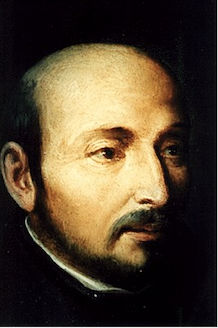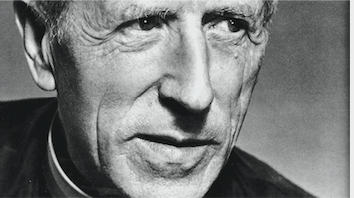
A post on St. Ignatius Loyola might seem to make the above title incongruous, but a love story is at the heart of the man. Ignatius, a Basque mystic who in the 16th century founded The Society of Jesus, whom we know as Jesuits, wrote that the everyday world is the medium in which love is encountered and embraced, and that in this exchange our humanity reaches its fulfillment.
Understanding Ignatius in the context of a passionate love story may seem far fetched, but this was a man who grasped a truth 450 years ago we would do well to try now to get our heads around. For Ignatius, the created world and our human life in it is a gift not to be taken for granted but to be savored, because every moment of it contains the potential for love’s revelation. To see the full scope of our lives and the entirety of creation as “… a means of encounter and union,” changes how we see ourselves and our position in such a place. Ignatius would have us use the same set of eyes God uses, eyes beholding their beloved, for whom no gift is too extravagant and no effort towards intimacy too much. In this encounter you have been found to be lovable, and from this place of complete acceptance, most especially in coming to believe in your acceptableness, you are brought into a situation where the state of being loved, and of loving in return becomes as instinctual as breathing.

The 20th century French philosopher, scientist, and Jesuit priest, Pierre Teilhard de Chardin S.J., described a view of the world that gives us a sense of how to make real the terms of Ignatius’ love story. Teilhard defines the created world as a “divine milieu,” writing that the very air we breathe is ‘of God.’ He writes,
“All around us, to right and left, in front and behind, above and below, we have only had to go a little beyond the frontier of sensible appearances in order to see the divine welling up and showing through.”
Teilhard was writing as a scientist with all the tools of the 20th century at his disposal, but it was with this perspective four centuries earlier Ignatius conceived of a way to grasp and then respond to such a “welling up and showing through.” Ignatius wrote,
“… love consists in mutual communication. That is to say, the lover gives and communicates to the loved one what they have,” … “and in turn the one loved does the same for the lover.” … “Each gives to the other.”
Now Ignatius gets personal. Mutual communication is only possible between two parties who are engaged with each other. Picture a beloved of yours, they suffuse themselves into every aspect of your being. It is no different between you and God. And it is not the God who sits in judgement, not the God who keeps score, and not the God whom you must clean house for before inviting her over. This God, the one Ignatius wants us to get to know, is interested in one thing –– that would be you. The you who does not have all the answers, the you who has missed the mark a time or two, the you who does not trust in your own worthiness. So you can see it is personal and it is demanding, but Ignatius has faith in you, knowing it is your nature to desire this acceptance, and it is God’s nature to find you glorious.
Having founded a religious order, Ignatius created a tool for the members to encounter this God whom he had experienced. The Spiritual Exercises of St.Ignatius, a retreat designed to introduce others to this God, have been made by literally millions of people since Ignatius created them in 1524. These ‘Exercises’ are made up of meditations, contemplations, and prayers, designed as a month long movement towards intimacy with the ‘lover’ who desires nothing more than relationship with their ‘beloved.’
The Spiritual Exercises are divided into four distinct movements, called ‘weeks,’ although their duration is flexible. Many people, busy with their lives and families, unable to go into seclusion for a month, are still able to receive the Exercises in a format that extends the period for several months. This kind of adaptability is intrinsic to Ignatius’ attitude, towards our foibles and weaknesses and towards God’s patience with us. Ignatius can be just as structured as he needs to be, but at the same time grant that ‘if that isn’t working, try something different.’ What is most important in approaching these Exercises is the attitude a person brings with them in the endeavor. Michael Ivens S.J. describes the Exercises as for the ‘large hearted,’ people characterized by their ‘liberality towards God.’ Fr. Tom Lamanna S.J. calls it “the genius of Ignatius,” in paraphrasing an Ignatian prayer, “I am loved and called to live out that truth. It is the journey of a lifetime to come to accept and then grab a hold of this fact.”
If you have been blessed to have received the Spiritual Exercises of St. Ignatius, you are well aware of the seismic shift they bring forth. I describe the arc of my life, without exaggeration, as the years ‘pre’ and ‘post’ my receiving the Exercises. I am a different person because of them, not by any stretch a completed project, but indelibly changed. At their essence, the entire dynamic of the Exercises is about freedom. To be made a little bit freer to where the “continuous welling up and showing through” of God is encountered in the most prosaic of moments. This is the ‘divine milieu’ Teilhard wrote of, an environment that asks only for us to pay attention, since every moment is just waiting for us to recognize divinity revealing itself right before our eyes. Within a milieu such as this, unencumbered of fear, we become free to live and love exuberantly, in the thrall of a lover such as this.
I hope, if you ever have the opportunity, to experience the earth shift under your feet in your encounter of these Exercises, seeing yourself as the object of such love and desire.